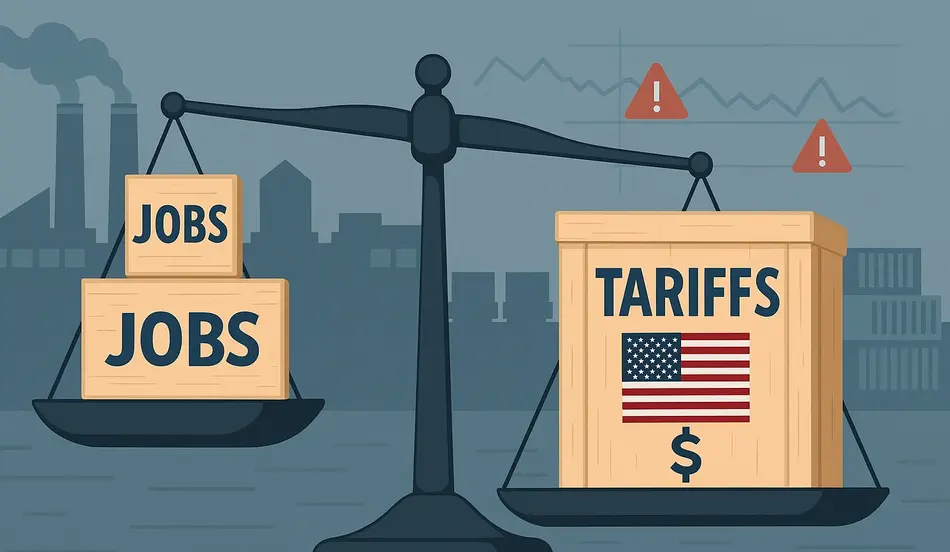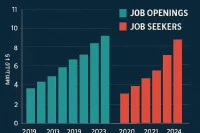The first full month of President Donald Trump tariffs-driven trade policies has brought a wave of uncertainty to businesses, consumers, and economists alike. Yet despite fears of disruption, the U.S. labor market has continued to show resilience, with the latest jobs report revealing steady, if slowing, growth.
The Department of Labor announced that the U.S. economy added 139,000 jobs in May, a figure that exceeded economists’ forecasts but still reflected a slowdown from April. The report offered a mixed picture: while hiring continued in several key industries, weakness emerged in manufacturing and government jobs, two areas closely tied to broader policy and economic confidence.
Economists warn that the unpredictable nature of Trump’s tariff decisions — described by some as “on-again, off-again” — has left many businesses in limbo, unsure of how to plan for the future. With inflation numbers due next week and the Federal Reserve set to meet shortly after, all eyes are now on how policymakers will respond to an economy navigating turbulent trade waters.
Jobs Report at a Glance
- Total jobs added in May: 139,000
- Sectors with strongest growth: Healthcare; Leisure and Hospitality (+48,000 jobs, more than double its average pace)
- Weaknesses: U.S. manufacturing declined for a third consecutive month; federal government employment fell by 22,000
- Unemployment rate: Largely unchanged
- Fed outlook: Economists say the report makes it unlikely the central bank will cut interest rates this month
“This report shows the U.S. workforce is still resilient,” said Ernie Tedeschi, an economist who has closely tracked labor trends under Trump. “If the Fed were looking for meaningful weakness to justify a rate cut, this wasn’t it.”
A Labor Market Under Pressure
While job creation remains positive, the latest figures mark a slowdown compared to the brisk pace seen earlier in the year. For context, April added closer to 175,000 jobs, and many analysts had expected May’s number to be closer to 120,000.
The gains, though smaller, were unevenly distributed across industries:
- Healthcare continued to be a pillar of strength, adding tens of thousands of jobs as hospitals, clinics, and eldercare facilities responded to growing demand.
- Leisure and hospitality, boosted by seasonal hiring and a rebound in consumer spending, posted 48,000 new positions — a striking increase compared to its average of about 20,000 jobs a month over the past year.
- Government employment, however, declined significantly, losing 22,000 jobs in May. Most of those losses came from the federal level, reflecting ongoing budget constraints and Trump’s broader push to streamline agencies.
- Manufacturing, long touted as a centerpiece of Trump’s “America First” agenda, continued to contract. The sector shed 11,000 jobs in May and has now lost 28,000 positions over the past six months.
“This is the third month in a row that manufacturing has fallen,” noted one industry analyst. “That is deeply concerning given how central factories are to both Trump’s rhetoric and America’s economic identity.”
The Trump Tariffs Effect
The most immediate cloud hanging over the economy is the tariff battle. The Trump administration has imposed duties on a wide range of imports, from steel and aluminum to consumer goods. While some of those tariffs have been rolled back or adjusted, others remain firmly in place — and economists say the back-and-forth policy shifts are rattling both domestic businesses and foreign trade partners.
“We’re in a situation of radical uncertainty,” said Mario Cordero, CEO of the Port of Long Beach, one of America’s busiest trade hubs. “Prices are going to go up no matter what, and the real question is how high.”
Cordero added that port traffic is already showing signs of strain, with fewer goods moving in and out compared to the same period last year. That decline is a warning sign not only for shipping companies but also for consumers, who may soon feel the impact in the form of higher prices.
Economist Abby Hall put it bluntly: “It’s not just this nebulous macro economy that’s being affected. It’s people’s day-to-day lives, their budgets, and their ability to plan ahead.”
Strengthen Your Workforce in Uncertain Times
Tariffs and trade shifts may disrupt markets, but businesses that keep hiring stay resilient. Post your job on WhatJobs and connect with professionals ready to help your company navigate challenges and grow despite uncertainty.
Post a Job Now →Consumers on Edge
For ordinary Americans, the big question is whether tariffs will lead to higher prices for goods ranging from clothing to electronics to food. Historically, when tariffs are imposed, importers and retailers either absorb the cost or pass it on to consumers.
So far, many companies have tried to shoulder the burden, but analysts say that strategy isn’t sustainable long term. “You can only hold the line on prices for so long,” said one retail executive. “Eventually, the costs will trickle down to Main Street.”
The uncertainty has already complicated household decision-making. Consumers are pulling back on discretionary purchases in anticipation of rising costs, surveys show. Confidence levels remain positive overall but have shown signs of dipping compared to late last year.
The Federal Reserve’s Balancing Act
The jobs report has immediate implications for the Federal Reserve, which sets U.S. interest rates. Markets had been speculating that the Fed might cut rates in response to economic uncertainty. However, the steady job gains in May appear to reduce the likelihood of an immediate move.
“What would have made a cut more likely would have been clear weakness in this jobs report,” said economist Tedeschi. “And we didn’t see that.”
Still, the Fed faces a tricky balancing act. Inflation data due next week could shift the conversation. If inflation rises sharply due to tariffs, the Fed might be forced to keep rates higher for longer — even as businesses and consumers call for relief.
Trade War Meets Politics
Beyond the economics, the tariff issue is deeply political. Trump has long framed tariffs as a tool to rebalance global trade and protect American industries. His supporters argue the strategy is already paying dividends by forcing other countries to the negotiating table.
Critics, however, say the short-term costs to businesses and consumers outweigh the benefits. They argue that the tariff strategy risks eroding global confidence in U.S. trade policy and harming the very workers it was meant to protect.
The political stakes are high. With the 2026 midterm elections looming, every jobs report and every tariff announcement is being scrutinized for its potential impact on voter sentiment.
Sector Spotlight: Where the Jobs Are
Breaking down the latest labor report:
- Healthcare: Continued to dominate hiring, reflecting America’s aging population and rising demand for medical services.
- Leisure and Hospitality: Surged with 48,000 jobs, fueled by summer travel, tourism, and dining.
- Construction: Remained stable, with moderate gains tied to both residential and commercial projects.
- Manufacturing: Lost 11,000 jobs in May; six-month decline of 28,000 positions.
- Government: Fell by 22,000 jobs, mainly at the federal level.
This uneven distribution underscores a broader shift in the U.S. economy: while services continue to expand, traditional industries like manufacturing and government employment are shrinking.
What Comes Next?
Economists say the near future hinges on three key developments:
- Inflation Data – Due next week, these numbers will reveal whether tariffs are already pushing up consumer prices.
- Federal Reserve Decision – The Fed meets the following week to consider interest rates. Markets currently expect no immediate cut, but further weakness could change that outlook.
- Tariff Policy Changes – With the Trump administration known for sudden announcements, businesses remain wary of new or expanded tariffs that could disrupt supply chains overnight.
Plan Ahead—Secure Your Workforce Now
With inflation data, Fed decisions, and shifting tariff policies shaping the future, one certainty remains: businesses that invest in talent are better prepared. Post your job on WhatJobs today and connect with professionals ready to help you adapt and thrive.
Post a Job Now →Broader Economic Picture
Despite the turbulence, the U.S. economy remains relatively healthy compared to other major nations. Unemployment is steady, consumer spending has not collapsed, and job growth, while slower, continues.
However, risks are mounting:
- Prolonged weakness in manufacturing could spill into related industries.
- Higher consumer prices could erode household budgets.
- Global trade partners may retaliate with tariffs of their own, dampening exports.
“We’re not in a recession, but we are at an inflection point,” one Wall Street strategist told Scripps News. “The next six months will be critical.”
FAQ: What This Means for You
Q1: Will tariffs make everyday goods more expensive?
Yes, tariffs typically raise costs. Importers may absorb some of the increase, but most experts say higher prices will eventually reach consumers on goods like clothing, electronics, and household items.
Q2: Why is manufacturing losing jobs if tariffs are meant to help factories?
While tariffs are designed to protect domestic industries, they also raise input costs and invite retaliation from other countries. That can reduce demand for U.S. exports and hurt manufacturers in the short term.
Q3: Could the Federal Reserve cut interest rates to offset uncertainty?
Not immediately. Economists say the May jobs report was too strong to justify a rate cut this month. But if future reports show weakness or inflation rises, the Fed could act later in the year.
Q4: Which industries are still hiring?
Healthcare and leisure/hospitality remain the biggest drivers of job growth. These sectors are less vulnerable to global trade disputes and more tied to domestic consumer demand.
Q5: What should small businesses expect?
Small firms that rely on imports may face higher costs and more paperwork due to tariffs. Many will need to decide whether to pass those costs on to customers or absorb them.
Conclusion
The May jobs report suggests that the U.S. labor market remains durable despite the turbulence of Trump’s tariffs. Yet beneath the surface, signs of stress are emerging, particularly in manufacturing and government employment. For consumers, businesses, and policymakers alike, the months ahead promise more uncertainty — and more scrutiny — as America navigates the economic fallout of its trade battles.




